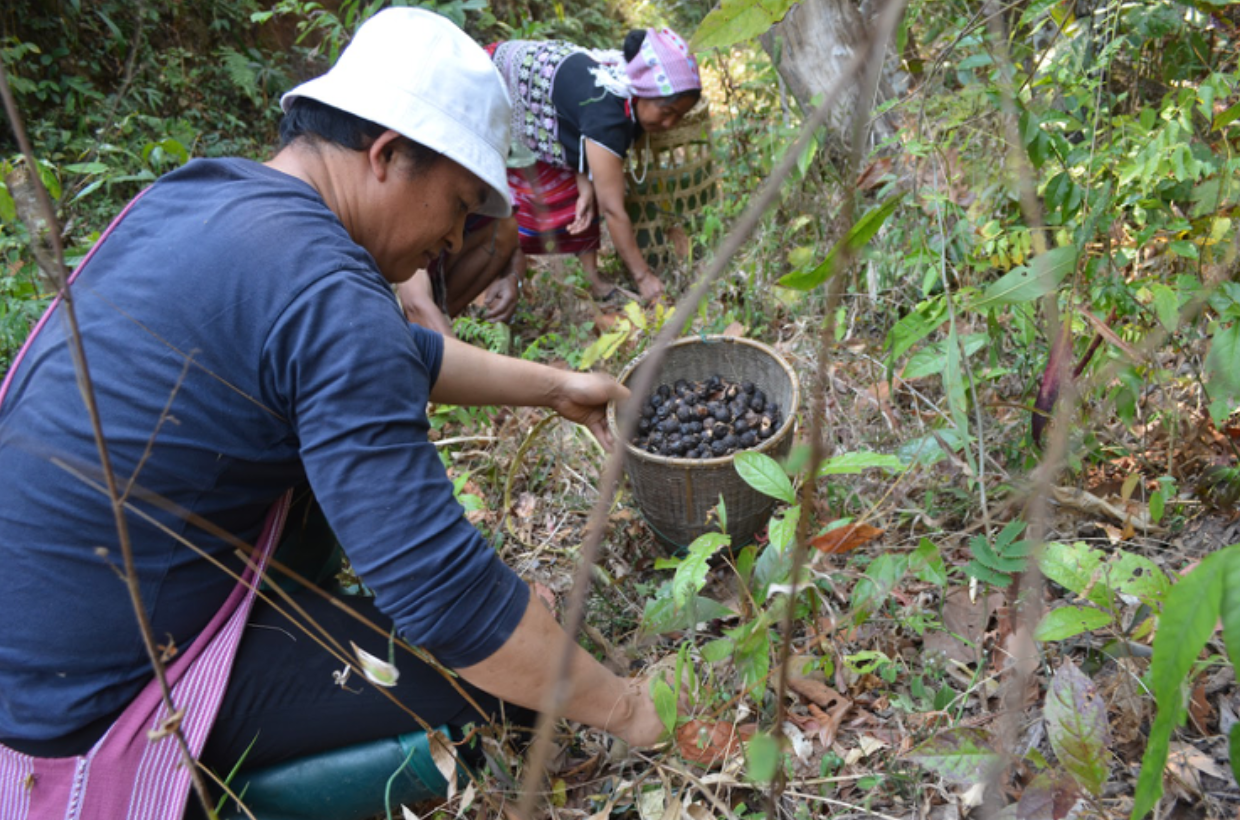
Rethinking Clean: A Return to Nature
Most commercial products are loaded with harsh, synthetic chemicals—many of them carcinogenic and harmful not just to consumers, but also to producers and the environment.
Even labels like "natural" or "organic" often don’t mean much, as these products still contain preservatives, artificial fragrances, and other toxic additives.
But that’s just the way it is, right? After all, how else do you get a rich lather? Or make a product shelf-stable?
That excuse was never good enough for us.
We knew there had to be a better way. And we found one.

Ancient wisdom meets microbiology
How we do it...
We asked ourselves a simple question:
"How did people clean themselves and their homes before commercial solutions existed?"
This search led our microbiologists deep into the villages of Northern Thailand, where local communities have been using soap nuts, herbs, and plant-based ingredients for centuries. These natural elements provided gentle yet powerful cleansing properties—without a single synthetic additive.
Combining the research of Dr. Teruo Higa, a pioneering Japanese microbiologist who introduced the world to the power of Effective Microorganisms (EM) with traditional knowledge proved effective. His work demonstrated how beneficial probiotics could be harnessed to create balance in both our bodies and the environment.
Inspired by both traditional wisdom and modern microbiology, we developed a pioneering fermentation method that blends:
- Wild-harvested soap nuts for gentle cleansing
- Probiotic cultures to restore microbiome balance
- Botanical extracts for degreasing, nourishment and protection
The result? Truly clean, toxin-free products that work in harmony with nature—without compromising on performance.
Mindfully chosen local ingredients each with a specific purpose
Ingredient Glossary
Soap Nut
Sourced From: a species of the lycee family, soap nut or soapberry is found amongst small trees across India and South East Asia
Scientific Name: Sapindus mukorossi
Why We Use It: Foaming Agent
Only naturally-occurring saponin found in the fruits of the Sapindus tree commonly known as soapnut is used as a surfactant (the foaming agent) in our products. These fruits are sustainably wildcrafted and the saponin is extracted from the fruits by a simple soaking process using enzymes and microflora. No chemical or chemical process involved. Our products are safe and hypoallergenic, perfect for those with sensitive skin.
✔ No Sodium Lauryl Sulfate (SLS)
✔No Sodium Laureth Sulfate (SLES)
✔No Ammonium Lauryl Sulfate (ALS)
✔No Saponification (chemical reaction of vegetable oil and sodium or potassium hydroxide to create lather)
Indian Laurel Leaf
Sourced From: this 'lucky' leaf, also known as Bai Mee in Thai is found on trees across the Mediterranean and Asia.
Scientific Name: Ficus Mircrocarpa
Why We Use It: Emulsifier to bind the water and oil based ingredients
The active ingredient of this leaf is Mucilage Polysaccharides, and this is responsible for the gel-like thickness in our products.
Typically, Sodium Chloride and PEG Polyethelyne or Polyoxyethelyne are used in commercial brands of shampoo, body wash, dish soap, and even baby products!
Kaffir Lime
Sourced From: A citrus fruit native to tropical Asia, Kaffir lime is widely grown across Thailand, Indonesia, and Malaysia. It's used in both food and traditional medicine.
Scientific Name: Citrus hystrix
Why We Use It: Scalp & Hair Care
Kaffir lime is rich in antioxidants and natural compounds that nourish the scalp and strengthen hair. Traditionally used in Southeast Asia for its cleansing and therapeutic properties, it helps reduce dandruff, prevent hair fall, and deeply moisturise both hair and scalp.
Elephant Apple
Sourced From: A tropical fruit found in Southeast Asia, Elephant Apple thrives in humid forests across Thailand, India, and Sri Lanka. It gets its name from the fact that elephants love to snack on these fruits in the wild.
Scientific Name: Dillenia indica
Why We Use It: Nourishment of skin and scalp
Elephant Apple contains antioxidants like Vitamin C, Vitamin E, and flavonoids, which help support collagen production—keeping skin firm, hydrated, and healthy. Its natural conditioning properties enhance hair’s softness and shine, creating a silky texture without the need for synthetic silicones. Traditionally used in herbal remedies, this nutrient-rich fruit helps protect and revitalize both skin and hair, making it a key ingredient in our plant-based formulations.
Pineapple
Sourced From: Grown in tropical climates, Pineapple is widely cultivated across Thailand
Scientific Name: Ananas Sativus
Why We Use It: Natural Degreaser
Pineapple is a powerful natural cleanser, thanks to its enzymes that effectively break down oil, dirt, and buildup. These enzymes work as gentle yet effective degreasers, making it easier to lift away residue without the need for harsh chemicals. In addition to its cleansing properties, Pineapple also contains antioxidants that help protect and refresh the skin, leaving it feeling clean and revitalized.
Rice Bran
Sourced From: Derived from the outer layer of rice grains, Rice Bran is a staple in traditional beauty rituals across Thailand, Japan, and other parts of Asia.
Scientific Name: Germ Triterpenoids
Why We Use It: Natural Hair Conditioner
Rich in germ triterpenoids, essential fatty acids, and antioxidants, Rice Bran deeply nourishes and softens hair, making it a key ingredient in our conditioner. It helps smooth the hair cuticle, reducing frizz and enhancing shine without relying on synthetic silicones. Used for centuries in hair and skincare, this gentle yet powerful ingredient conditions and strengthens hair while keeping our formulations 100% plant-based.
Cinnamon
Sourced From: Harvested from the inner bark of trees, Cinnamon has been used for centuries in traditional medicine and personal care across Southeast Asia.
Scientific Name: Cinnamomum Cassia Bark Extract
Why We Use It: Natural Anti-microbial
Cinnamon is rich in natural antimicrobial and antioxidant properties, making it an excellent ingredient for scalp and skin care. It helps stimulate circulation, promoting a healthy scalp environment for stronger hair growth while gently cleansing and refreshing the skin. With its warming properties and invigorating scent, Cinnamon enhances both the effectiveness and sensory experience of our formulations—without the need for synthetic additives.
Amala Gooseberry
Sourced From: Native to South and Southeast Asia, Amla (Indian Gooseberry) has been a staple in Ayurvedic and traditional herbal remedies for centuries.
Scientific Name: Phyllanthus Emblica Fruit Extract
Why We Use It: Hair & Scalp Strengthener
Amla is packed with Vitamin C, antioxidants, and essential nutrients that nourish the scalp and strengthen hair from root to tip. It helps reduce hair fall, promote hair growth, and enhance natural shine while soothing the scalp. Its powerful antioxidant properties also protect hair from environmental stressors, making it a key ingredient in our plant-based formulations for stronger, healthier hair.
Effective Microogranisms
Sourced From: A carefully cultivated blend of beneficial bacteria and yeast, Effective Microorganisms (EM) are naturally occurring probiotics used in fermentation and eco-friendly cleaning.
Scientific Name: Lactobacillus Casei, Rhodopseudomonas Palustris, Saccharomyces Cerevisiae
Why We Use It: Probiotic Cleansing & Skin Microbiome Support
This powerful mix of probiotics works to balance and restore the skin’s natural microbiome while enhancing the cleansing power of our products. Lactobacillus Casei helps maintain a healthy bacterial balance, Rhodopseudomonas Palustris aids in breaking down impurities, and Saccharomyces Cerevisiae supports fermentation, allowing for natural preservation without synthetic chemicals. These microorganisms not only promote skin health but also boost the biodegradability of our formulations, ensuring a minimal impact on the environment.
